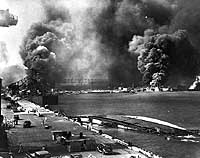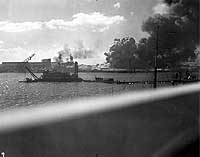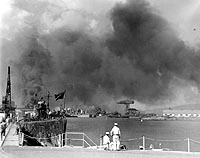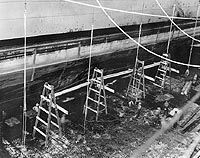
The initial Japanese attack wave hit the Pearl Harbor Navy Yard area relatively lightly, with a few torpedoes launched at ships along 1010 Dock and some dive bombers targeting that vicinity and the drydock area immediately to the southward. The torpedo planes made one hit, on the light cruiser Helena, opening two of her engineering spaces to the sea. The minelayer Oglala, tied up alongside Helena, fared much worse. This old converted passenger ship had her port side opened up by the blast of the torpedo that hit the cruiser, and the resulting inrush of water could not be controlled. About two hours later, Oglala rolled over to port and sank alongside 1010 Dock.
The second Japanese attack wave's horizontal and dive bombers gave the Navy Yard's drydock area considerable attention. Though their efforts were somewhat mitigated by the diversion of some planes against USS Nevada as she passed nearby, these bombers made several hits, wrecking three destroyers and damaging the battleship Pennsylvania. The latter, Flagship of the Pacific Fleet and one of the raiders' priority targets, was "high and dry" in Drydock # One with destroyers Cassin and Downes. One bomb hit Pennsylvania amidships, killing eighteen crewmembers and producing modest damage to the battleship. Other bombs, hitting on and near the two destroyers, opened their fuel tanks and set intense fires. Ammunition explosions, including the detonation of a torpedo on Downes, added to the destruction, which was compounded when the drydock was partially flooded. Cassin then lifted off her blocks and rolled over against Downes.
Dive bombers from the second wave also struck the destroyer Shaw, which was in the floating drydock YFD-2. The resulting fires spread to Shaw's forward magazines, which blew up spectacularly, severing her bow. However, the rest of the ship remained afloat as the drydock sank beneath her. The little tug Sotoyomo, also in YFD-2, was badly burned by Shaw's fires and went down, too.
Japanese bombs near-missed some of the ships at the piers in the northeastern part of the Navy Yard, producing notable damage to the hull of light cruiser Honolulu. However, the attackers' concentration on battleship targets left the Yard's vital industrial facilities essentially untouched. These were soon hard at work on rescue, repair and salvage jobs, of which there were many immediately at hand.
This page features views of the 7 December 1941 Japanese attack on ships in and near the Pearl Harbor Navy Yard.
For further views of ships and other scenes in the Pearl Harbor Navy Yard area during or soon after the the Japanese attack, see:
For additional pictorial coverage of the Japanese attack
on Pearl Harbor, see:
| If you want higher resolution reproductions than the Online Library's digital images, see: "How to Obtain Photographic Reproductions." |
Click on the small photograph to prompt a larger view of the same image.
|
Photo #: KN-32031 (Color) "The Japanese Sneak Attack on Pearl Harbor" Charcoal and chalk by Commander Griffith Bailey Coale, USNR, Official U.S. Navy Combat Artist, 1944. For more information on this artwork, see: Photo # KN-32031 (complete caption). Courtesy of the U.S. Navy Art Center, Washington, D.C. Official U.S. Navy Photograph. Online Image: 73KB; 900 x 300 pixels Reproductions of this image may also be available through the National Archives photographic reproduction system as Photo # 428-KN-32031 |
 |
|
Photo #: 80-G-474789 Pearl Harbor Attack, 7 December 1941 View from Pier 1010, looking toward the Pearl Harbor Navy Yard's drydocks, with USS Shaw (DD-373) -- in floating drydock YFD-2 -- and USS Nevada (BB-36) burning at right, 7 December 1941. In the foreground is the capsized USS Oglala (CM-4), with USS Helena (CL-50) further down the pier, at left. Beyond Helena is Drydock Number One, with USS Pennsylvania (BB-38) and the burning destroyers Cassin (DD-372) and Downes (DD-375). Official U.S. Navy Photograph, now in the collections of the National Archives. Online Image: 119KB; 740 x 610 pixels Reproductions of this image may also be available through the National Archives photographic reproduction system. |
 |
|
Photo #: 80-G-32953 Pearl Harbor Attack, 7 December 1941 View looking down Pier 1010 toward the Pearl Harbor Navy Yard's Drydock Number One, in center, which holds the battleship Pennsylvania (BB-38) and the burning destroyers Cassin (DD-372) and Downes (DD-375). Alongside Pier 1010, in the center middle distance, are the light cruiser Helena (CL-50), listing slightly from a torpedo hit, and the capsized minelayer Oglala (CM-4). Taken on 7 December 1941. Official U.S. Navy Photograph, now in the collections of the National Archives. Online Image: 76KB; 740 x 610 pixels Reproductions of this image may also be available through the National Archives photographic reproduction system. |
 |
|
Photo #: 80-G-32580 Pearl Harbor Attack, 7 December 1941 View looking toward the Pearl Harbor Navy Yard from Ford Island, with a dredge in the middle distance, 7 December 1941. USS Downes (DD-375) and USS Cassin (DD-372) are burning in the front of Drydock Number One, center, with USS Pennsylvania (BB-38) also in the dock, at left center. USS Shaw (DD-373) is burning at right. Official U.S. Navy Photograph, now in the collections of the National Archives. Online Image: 75KB; 740 x 605 pixels Reproductions of this image may also be available through the National Archives photographic reproduction system. |
 |
|
Photo #: NH 50931 Pearl Harbor Attack, 7 December 1941 Torpedo planes attack "Battleship Row" at about 0800 on 7 December, seen from a Japanese aircraft. Ships are, from lower left to right: Nevada (BB-36) with flag raised at stern; Arizona (BB-39) with Vestal (AR-4) outboard; Tennessee (BB-43) with West Virginia (BB-48) outboard; Maryland (BB-46) with Oklahoma (BB-37) outboard; Neosho (AO-23) and California (BB-44). West Virginia, Oklahoma and California have been torpedoed, as marked by ripples and spreading oil, and the first two are listing to port. Torpedo drop splashes and running tracks are visible at left and center. White smoke in the distance is from Hickam Field. Grey smoke in the center middle distance is from the torpedoed USS Helena (CL-50), at the Navy Yard's 1010 dock. Japanese writing in lower right states that the image was reproduced by authorization of the Navy Ministry. U.S. Naval History and Heritage Command Photograph. Online Image: 144KB; 740 x 545 pixels |
 |
|
Photo #: 80-G-32704 Pearl Harbor Attack, 7 December 1941 View looking toward the Navy Yard from the Submarine Base during the attack. Submarine in the left foreground is USS Narwhal (SS-167). In the distance are several cruisers, with large cranes and 1010 Dock in the right center. Note Sailors in the center foreground, wearing web pistol belts with their white uniforms. Official U.S. Navy Photograph, now in the collections of the National Archives. Online Image: 63KB; 740 x 610 pixels Reproductions of this image may also be available through the National Archives photographic reproduction system. |
 |
|
Photo #: NH 64478 USS Honolulu (CL-48) Damage on the port side of the cruiser's hull, extending fore and aft about 40 feet from about Frame 40. It was produced by a Japanese 250 kilogram bomb that exploded about 20 feet away during the 7 December 1941 air raid on Pearl Harbor. The blast dished-in the hull five or six feet, resulting in heavy flooding inside the ship. Photographed in Drydock Number One at the Pearl Harbor Navy Yard, 13 December 1941. View looks forward, with the ship's armor belt immediately above the damage area. Official U.S. Navy Photograph, from the collections of the Naval History and Heritage Command. Online Image: 95KB; 740 x 605 pixels |
 |
|
Photo #: NH 83060 USS Honolulu (CL-48) Drydocked at the Pearl Harbor Navy Yard, 13 December 1941, showing damage below the waterline inflicted by a Japanese bomb that exploded nearby during the 7 December 1941 air raid. Note what appears to be a light toned paint scheme on the ship's side above the boot topping. Collection of Vice Admiral Homer N. Wallin. Official U.S. Navy Photograph, from the collections of the Naval History and Heritage Command. Online Image: 143KB; 740 x 610 pixels |
 |
For further views of ships and other scenes in the Pearl Harbor Navy Yard area during or soon after the the Japanese attack, see:
For additional pictorial coverage of the Japanese attack
on Pearl Harbor, see:
NOTES:
| If you want higher resolution reproductions than the Online Library's digital images, see: "How to Obtain Photographic Reproductions." |
Page made 5 November 2000;
Coding updated 17 April 2009